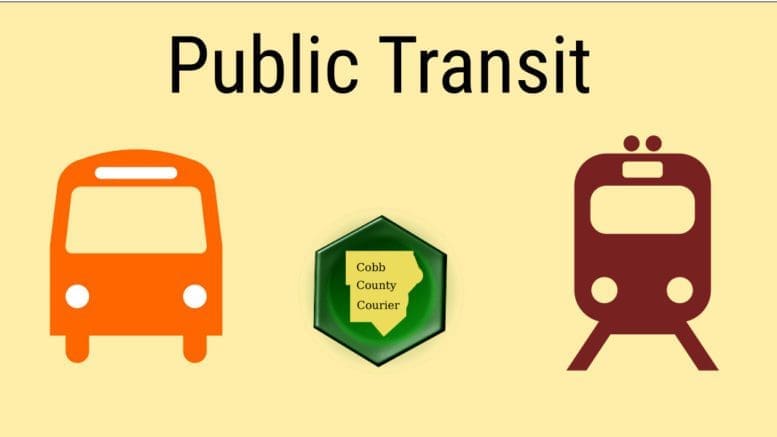By Arielle Robinson
Cobb County Department of Transportation Director Drew Raessler presented to Mableton’s City Council on April 10 about the upcoming transit referendum.
Cobb voters will have the opportunity to decide on expanded public transit on the November ballot.
In 2018, the Georgia General Assembly created an opportunity for counties to vote on a transit SPLOST. The majority of Cobb voters have to approve the measure for it to pass. If passed, public transportation is planned to start being worked on in 2025 in multi-year plans and be fully completed in Cobb by around 2055.
Raessler said the point of his presentation is to educate, not advocate for expanded transit.
The Cobb DOT director said the project’s major goals are to enhance mobility options throughout the county, connect people to jobs and housing, lower transportation costs for households, provide innovative solutions for efficient travel, and support a thriving future for Cobb.
Raessler said that Cobb’s population and employment growth over the next three decades will see about a 30 percent increase. This growth will lead to more demands on the transportation system.
The key connections are:
- Three MARTA stations, which are the Dunwoody, Arts Center and H.E. Holmes Stations
- 14 countywide microtransit zones
- All seven Cobb cities
- All three Community Improvement Districts
- Centralized employment and healthcare centers
- The Battery Atlanta
- Higher education institutions
- Bicycle and pedestrian accessibility
- The Hartsfield-Jackson International Airport
Raessler then presented a pie chart showing the percentage of funding assigned to each transit project.
For example, 41 percent of funding will go toward high-capacity transit, 19 percent toward transit operations, 14 percent towards transit vehicles, facilities and amenities and 14 percent towards microtransit, among the numbers shown.
Raessler said that people often think of trains when it comes to high-capacity transit, but bus rapid transit (BRT) is what is proposed in Cobb.
Raessler said that BRT is becoming the system of choice for high-capacity transit. He also said the BRT is planned to have the look and feel of a rail station and have the passenger amenities of one. It is supposed to be very quick, the vehicle pulls up and people load onto it, and information will be shared that shows the time the next vehicle will be there.
Additionally, there will be an off-board fare collection and the transportation frequency is typically between 15 to 20 minutes.
Newly created dedicated lanes for transit will allow the BRT to bypass highway congestion.
“Those dedicated lanes allow for competitive trips,” Raessler said. “And when we looked at, actually, a study that was done now a little bit more than 10 years ago that compared light rail along the Northwest Corridor and BRT, those travel times were equivalent between the two because of those dedicated lanes, providing increased reliability and accessibility.”
Raessler then discussed microtransit.
“So if BRT and high capacity transit are the tent poles, we’ll say then microtransit service is really the canvas that covers that tent,” he said.
The DOT director said microtransit has also become very popular across the United States.
The microtransit service is said to have countywide coverage, on-demand scheduling, curb-to-curb shared service within the service area, connections to community resources and the transit network and response times under half an hour.
It also has connections outside the service area through fixed routes.
Raessler said microtransit will operate similarly to Uber or Lyft.
“You could have an app or a way to call a vehicle that can take you curb to curb within that zone,” Raessler said. “So perhaps you work or you live somewhere just around here, but you work at Six Flags, and it’s maybe a little bit too far of a walk. You’re able to hail a ride and go straight…to your home. And the advantage of microtransit, of course, is providing that last mile of connectivity that has been such the challenge of transit over the years. It is still a public transit trip. So it may pick up me and then pick up Councilman [TJ] Ferguson and drop off me and then drop off the councilman, so it’s still a shared trip and it’s operating in minivans or very small buses.”
Raessler said a great question he has received is if microtransit is so similar to Uber or Lyft, why not just go with one of those services?
“Uber and Lyft are fantastic…but ultimately Uber is just a software and it is a private company, so we are not able to provide them funding directly. Two, we are not able to independently verify anything about those drivers or those vehicles to make sure that those drivers have been screened and that those vehicles have been appropriately maintained and inspected,” Raessler said.
Raessler also said there will be local, rapid and other service enhancements.
As mentioned earlier, despite much-needed and desired public transportation possibly coming to Cobb, the plan is not set to kick in until about 30 years from now, in 2055. This made some residents unhappy.
Raessler addressed this concern.
“Ultimately, though, public transportation or public infrastructure is a long-term investment,” Raessler said. “We look at East-West Connector, that was a 30-plus year investment in mobility.
“The reason that the legislature allows for additional time on the transit SPLOST is because transit is so operationally heavy…If we were to win a federal grant for one of these services, the federal government wants to make sure that their investment is protected for the long term. And so they will actually look at it and the competitiveness to make sure that, sure, you can build it, sure you can operate it for two or three years, but can you operate it for the life of that project?”
Raessler said rather than 30 years, the DOT has tried talking about the project in terms of five years plus five years plus 20.
“In the first five years, what would be provided should the program be approved is all of the microtransit systems within cities would be operational. Now, I will note that just given the size of Mableton, we were not able to fit exactly into just one, it’s the only city we’re unable to fit all into one surface area. So that’s something we want to continue to look at. Perhaps there’s free transfers or there’s overlap of those areas,” Raessler said.
He also said some expanded fixed route services over to the Cumberland area will be within the first five years as well, so by 2030.
He also explained the part that is to be done by 2035.
“That will allow us some time to be able to do some of the initial planning and engineering work on the BRT systems,” Raessler said. “[In 10 years, so 2035] the first BRT system becomes operational, and what that connects very generally would be the South Cobb Transit Center, which is proposed to be located around the Cobb general hospital [WellStar Cobb Medical Center] at Austell and East-West Connector, a connection between that area and right through the heart of Mableton to the Six Flags Transit Center that would be operational at this point, and then a connection from there across I-20 into H.E. Holmes, providing a very quick and reliable trip right there through the core of the city, as wells as additional transit expansion along…Veterans Memorial Highway.”
Raessler, responding to a question Ferguson, said that one of the reasons the BRT is not delivered until 2035 to allow for public involvement, meeting with cities and engineering coordination to understand exactly what the engineer is building.
Raessler said in the full build, done by 2025, Cobb will then have full connectivity.
“So that BRT route that connected from the general hospital to Six Flags to H.E. Holmes now extends north into Marietta,” Raessler said. “There are rapid connections that go east towards the Cumberland area. Additionally…in the 10-year projection, we have a project ongoing now with the state where we’re looking at BRT along I-285. So it would provide a rapid connection between the South Cobb and west Fulton area and into the Cumberland and Perimeter areas, as well as of course the existing transit system that goes into the heart of downtown Atlanta.”
Raessler also said that updated transit technology, such as remotely monitoring traffic signals to improve traffic congestion, is also part of the referendum.
For transit supportive projects, Mableton will receive $100 million. These include access to trails and projects to improve areas such as the East-West Connector and Veterans Memorial Highway Southeast. There are 22 total.
Cobb MSPLOST would transfer the transit funding from property taxes to sales tax.
Raessler claims this expanded transit project can help the most vulnerable populations within Cobb, such as the elderly, the disabled, those without cars and those living in poverty. He also projects that the project will reduce demand for parking within business districts, meet the needs of an expanding Cobb County and of course, provide alternatives to traffic congestion. There should be 100 percent transit coverage to access jobs within Cobb.
Raessler then got into the next steps that need to be taken for this to happen.
Municipalities have already met with Cobb DOT.
“The tasks ahead of us are to continue to refine this,” Raessler said. “So that we are better able to educate the public about what’s included within it. And ultimately, there are some additional votes by the Cobb Board of Commissioners and the Atlanta Transit Link Authority that are necessary in order to get that onto the ballot that are all scheduled to be complete by June 11th.”
Ferguson spoke up to the audience in attendance.
“I just want to make sure you all understand that’s one of the main reasons why you wanted a city, because now we can have those conversations with DOT and kind of talk about routing and what makes sense, what’s the best thing for us as a city, another ‘feather’ to say why the city of Mableton is important,” Ferguson said.
Mayor Michael Owens thanked Raessler for his presentation.
“I want to say I hope that we can continue the partnership and dialogue,” Owens said. “Because one of the things that we’re still doing as a city is still putting together what our city will look like. We’re just getting ready to start our Comprehensive Plan, there’s our Downtown Development Authority that will be coming, so there are going to be things that we’re going to be implementing as a city that is going to be vital to partner with the county and specifically with DOT when we start looking at these lines and additional lanes or where we need to have stops and transit centers at, so I thank you for this but definitely ask for your continued partnership and cooperation.”
Raessler agreed and said he offers that “willingly and freely.”
Councilwoman Debora Herndon asked Raessler what the financial impact for Mableton residents would be.
Raessler said that the full picture of revenue that is projected over the next 30 years is within the $11 billion range.
“That includes both the local revenue, fare revenue projections from an increased expanded system and federal grant revenue in there as well,” Raessler said.
If approved, there will be an increase from 6 percent to 7 percent for SPLOST. The increase would go into effect on April 1, 2025, which is the first day of the second quarter of the year. Funds would start being collected in May of that year.

Arielle Robinson is a student at Kennesaw State University. She also freelances for the Atlanta-Journal Constitution and is the former president of KSU’s chapter of the Society of Professional Journalists as well as a former CNN intern. She enjoys music, reading, and live shows.
